Advertising on the Delhi Metro Train
The Delhi Metro, an integral part of the National Capital Region's (NCR) urban landscape, is a testament to modern transportation infrastructure. Spanning 10 color-coded lines and serving 256 stations, it covers a vast network extending over 350.42 kilometers. Since its inception in 1998, the metro has reshaped commuter experiences across Delhi, connecting prominent locations such as Connaught Place, Chandni Chowk, and Nehru Place, among others. This extensive network not only eases travel within the city but also extends into satellite cities like Noida, Gurgaon, and Faridabad, enhancing regional connectivity.
Construction of the Delhi Metro began with the unveiling of its inaugural elevated section on the Red Line, linking Shahdara to Tis Hazari, which opened on 25 December 2002. This milestone marked the beginning of a transformative era in Delhi's public transport, emphasizing reliability and efficiency. Subsequently, the Yellow Line introduced the city to its first underground stretch between Vishwa Vidyalaya and Kashmere Gate on 20 December 2004, further enhancing accessibility and setting new benchmarks for urban mobility.
The Delhi Metro stands as a beacon of progress, catering to millions of passengers daily and significantly reducing traffic congestion in Delhi's bustling streets. Its expansion continues to redefine urban commuting, making it a prime location for advertisers seeking to reach a diverse and captive audience during their daily journeys.
Table of contents
- Advertising on the Delhi Metro Train
- Benefits of Advertising on the Delhi Metro Train
- Importance of Advertising on the Delhi Metro Train
- Ad Format of Advertising on the Delhi Metro Train
- Factors Affecting the Cost of Advertising on the Delhi Metro Train
- Best Practices for Advertising on the Delhi Metro Train
- Guide for Creating Effective Advertising on the Delhi Metro Train
- Why Choose Ginger Media Group for Advertising on the Delhi Metro Train?
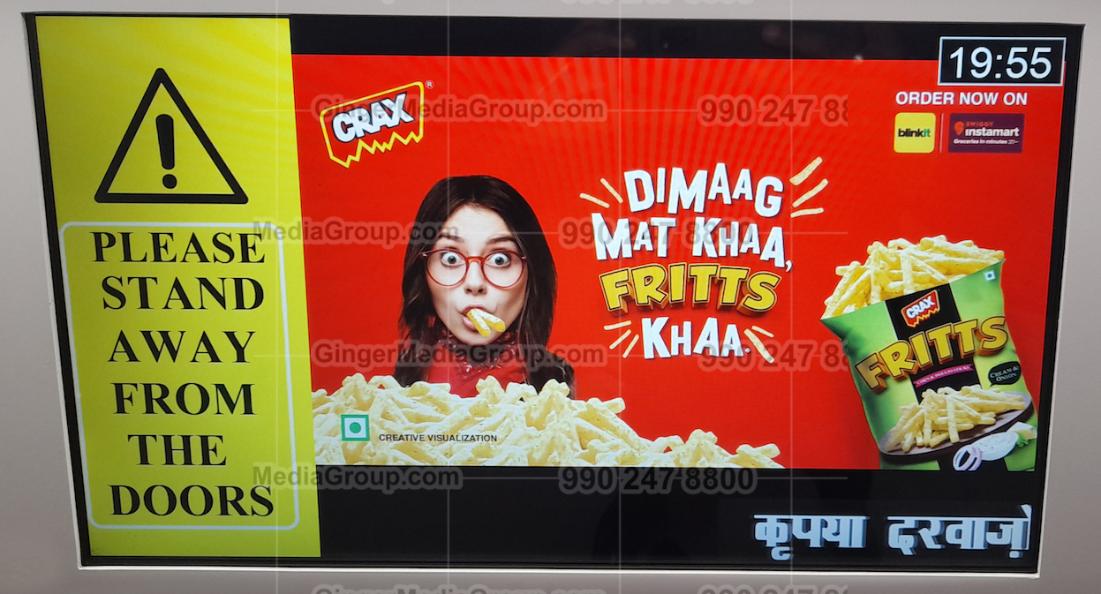
Benefits of Advertising on the Delhi Metro Train
Advertising in the Delhi Metro offers unparalleled access to a massive and diverse audience, comprising over 5 million commuters daily.
This extensive reach spans Delhi and its satellite cities in the National Capital Region (NCR), making it a prime location for brands aiming to enhance visibility and engagement among professionals, students, families, and tourists alike.
Massive Reach and Exposure
The Delhi Metro stands as one of the busiest metro systems globally, catering to over 5 million passengers daily. This immense footfall ensures that your advertisements reach a vast and diverse audience throughout the day.
Whether targeting business professionals traveling to Connaught Place or families commuting to cultural hubs like Chandni Chowk, the metro stations and trains offer strategic placements to maximize exposure. Brands can effectively build awareness and recognition among commuters from varied demographics, ensuring broad visibility across different times and routes within the NCR.
Targeted Advertising
Advertising in the Delhi Metro allows for precise targeting based on specific regions, demographics, or consumer behaviors. With stations strategically located across Delhi and NCR, advertisers can select locations that align with their target audience's geographic or socio-economic profiles.
For instance, stations in business districts like Nehru Place or Cyber City can target professionals, while university stations like Vishwa Vidyalaya can engage students. This flexibility enables advertisers to tailor their campaigns effectively, ensuring messages resonate with the right audience segments. Such targeted placements enhance the relevance and impact of advertisements, optimizing campaign ROI through focused messaging and strategic positioning.
Captive Audience
Commuters on the Delhi Metro typically spend an average of 20-30 minutes per journey, providing advertisers with a captive audience receptive to marketing messages. Unlike fast-paced mediums such as television or radio, where distractions abound, metro passengers are relatively focused during their travel. This focused environment increases the likelihood of message absorption and engagement, ensuring that ads resonate deeply with commuters.
Whether displayed on platform billboards, inside train panels, or on smart cards, advertisements in the Delhi Metro capitalize on these moments to deliver impactful brand messaging. This captive audience factor not only enhances brand recall but also facilitates deeper consumer engagement, driving desired actions and fostering brand loyalty among metro users.
High Recall Rate
Advertising in the Delhi Metro offers advertisers the advantage of high recall rates due to repeated exposure throughout commuters' daily journeys. Passengers encounter ads consistently across multiple touchpoints, including platforms, train interiors, and smart card displays.
This repeated exposure enhances brand recall and recognition significantly, reinforcing key messages and brand attributes in the minds of commuters. Studies indicate that frequent exposure within a controlled environment like the metro leads to better recall rates compared to more transient advertising mediums. As a result, brands leveraging the Delhi Metro for advertising campaigns benefit from increased top-of-mind awareness among their target audience, translating into higher brand recall and improved advertising effectiveness.
Cost-Effective Compared to Other Options
Advertising in the Delhi Metro offers a cost-effective alternative to traditional media channels like television or print, particularly advantageous for small and medium-sized enterprises (SMEs) seeking to maximize their advertising budget. The metro's extensive reach and high footfall provide substantial exposure at a fraction of the cost of prime-time television slots or full-page newspaper ads.
Moreover, metro advertising offers flexible pricing options tailored to varying budget sizes and campaign objectives, ensuring affordability and ROI optimization for advertisers. By reaching millions of commuters daily with targeted messaging, Delhi Metro ads enable brands to achieve broad market reach and visibility without the prohibitive costs associated with traditional mass media advertising. This affordability factor makes metro advertising a compelling choice for businesses aiming to enhance brand visibility, drive consumer engagement, and achieve marketing objectives efficiently within the dynamic Delhi NCR market.
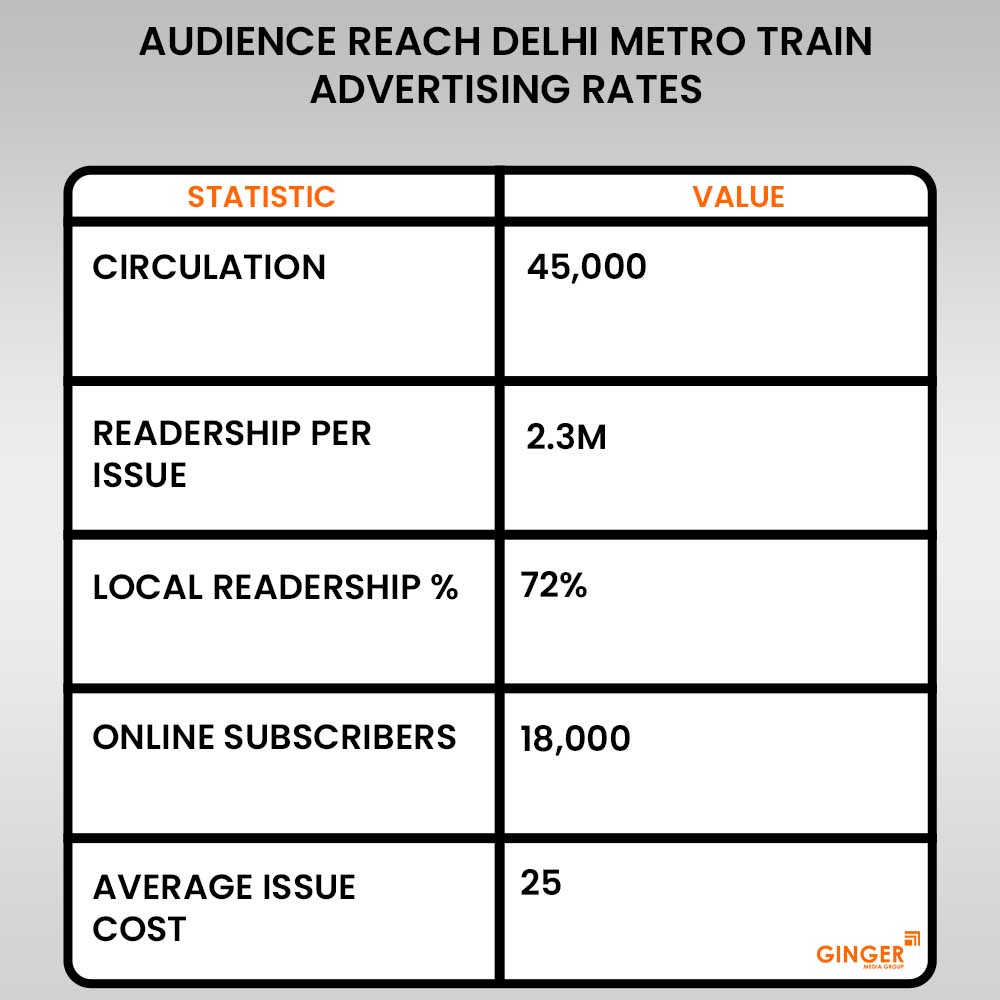
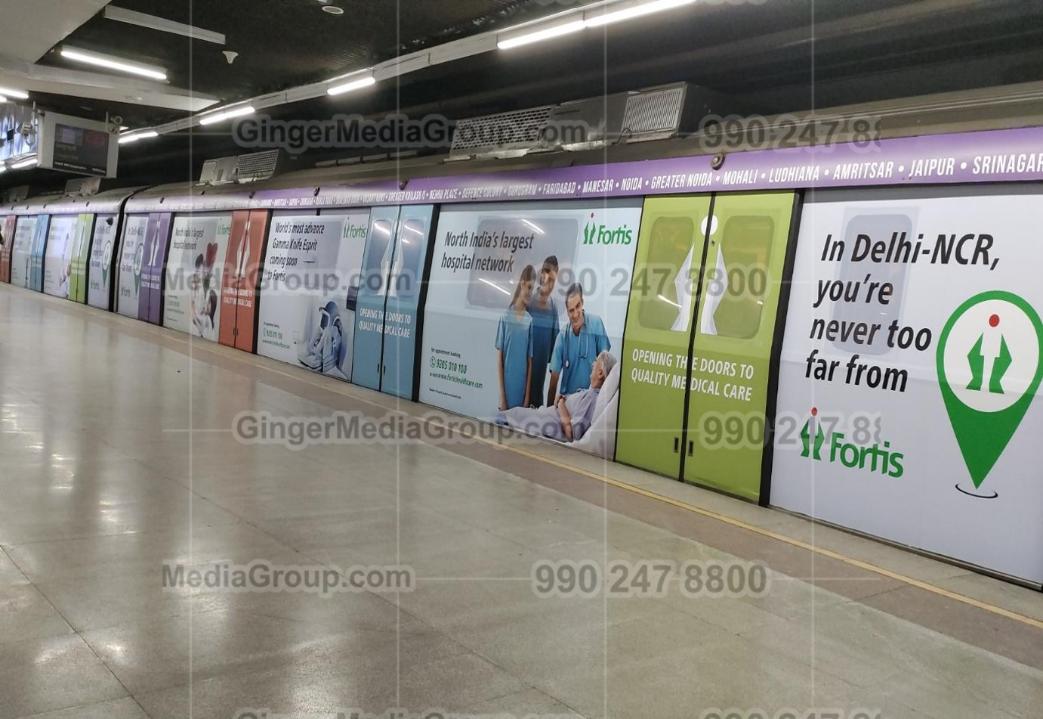
Importance of Advertising on the Delhi Metro Train
Advertising in the Delhi Metro holds significant importance for businesses aiming to establish a strong presence in one of India's largest and economically vibrant markets, the National Capital Region (NCR). With its strategic location, vast commuter base, and modern infrastructure, the Delhi Metro offers unparalleled opportunities for brands to enhance visibility, engage with affluent consumers, and strengthen brand equity in a dynamic urban setting.
Strategic Location
The Delhi Metro spans across Delhi and its satellite cities within the NCR, serving as a crucial transit link for millions of commuters daily. This strategic location places metro stations in close proximity to major business districts, educational institutions, residential hubs, and cultural landmarks. Advertising in the Delhi Metro allows brands to reach a large and diverse demographic, including professionals, students, tourists, and local residents.
By strategically placing ads at key stations like Connaught Place, Nehru Place, or Cyber City, businesses can effectively target high-traffic areas where consumers live, work, and socialize. This targeted approach not only enhances brand visibility but also facilitates direct engagement with potential customers, thereby driving brand awareness and preference in a competitive market environment.
Economic Powerhouse
Delhi is a thriving economic powerhouse and a hub for businesses, commerce, and cultural activities in India. Advertising in the Delhi Metro enables brands to tap into a market characterized by high purchasing power and substantial consumer spending. Metro ads provide a unique opportunity to connect with affluent consumers who utilize the metro for daily commutes, business meetings, shopping trips, and leisure activities.
By aligning with the metro's modern and efficient image, brands can position themselves as trustworthy and accessible choices within the competitive Delhi NCR market. This association with economic vibrancy and consumer prosperity enhances brand credibility and stimulates consumer interest, driving sales and fostering long-term brand loyalty among metro commuters.
Image Building
The Delhi Metro is renowned for its modern amenities, punctuality, and efficient service, earning widespread trust and reliability among commuters. Advertising in the metro allows brands to leverage this positive association to enhance their own brand image. By appearing alongside a respected public transport system, brands can convey messages of quality, reliability, and commitment to customer satisfaction. This alignment with the metro's reputable image not only strengthens brand credibility but also enhances brand recall and perception among target audiences.
Metro ads create lasting impressions on commuters, reinforcing brand attributes and values through consistent exposure across stations and train interiors. Over time, this continuous presence builds familiarity and trust, influencing consumer perceptions positively and driving brand affinity among metro users.
Part of Daily Life
For millions of Delhi residents, the Delhi Metro is an indispensable part of daily life, facilitating convenient and efficient travel across the city and its suburbs. Advertising in the metro allows brands to integrate seamlessly into commuters' daily routines, becoming a familiar presence during their journeys.
This consistent exposure builds brand familiarity and strengthens recall as commuters encounter ads multiple times throughout their travels. Metro advertising ensures that brands remain top-of-mind among consumers, influencing purchase decisions and brand preferences through repeated engagement. By becoming an integral part of commuters' daily experiences, brands can cultivate strong connections with their target audience, driving brand loyalty and advocacy over the long term.
Evolving Advertising Landscape
In today's digital age, where consumers are inundated with online advertisements, metro advertising offers a valuable offline touchpoint to complement digital marketing strategies effectively. Metro ads provide a tangible and immersive brand experience that engages consumers in a real-world setting, away from digital distractions. This offline engagement fosters deeper consumer connections and enhances the effectiveness of integrated marketing campaigns.
By combining metro advertising with digital initiatives, brands can achieve comprehensive reach and engagement, leveraging the strengths of both mediums to optimize advertising ROI. Metro ads serve as a strategic component of a well-rounded marketing strategy, enabling brands to reach diverse audiences, reinforce messaging, and drive measurable results in a competitive advertising landscape.
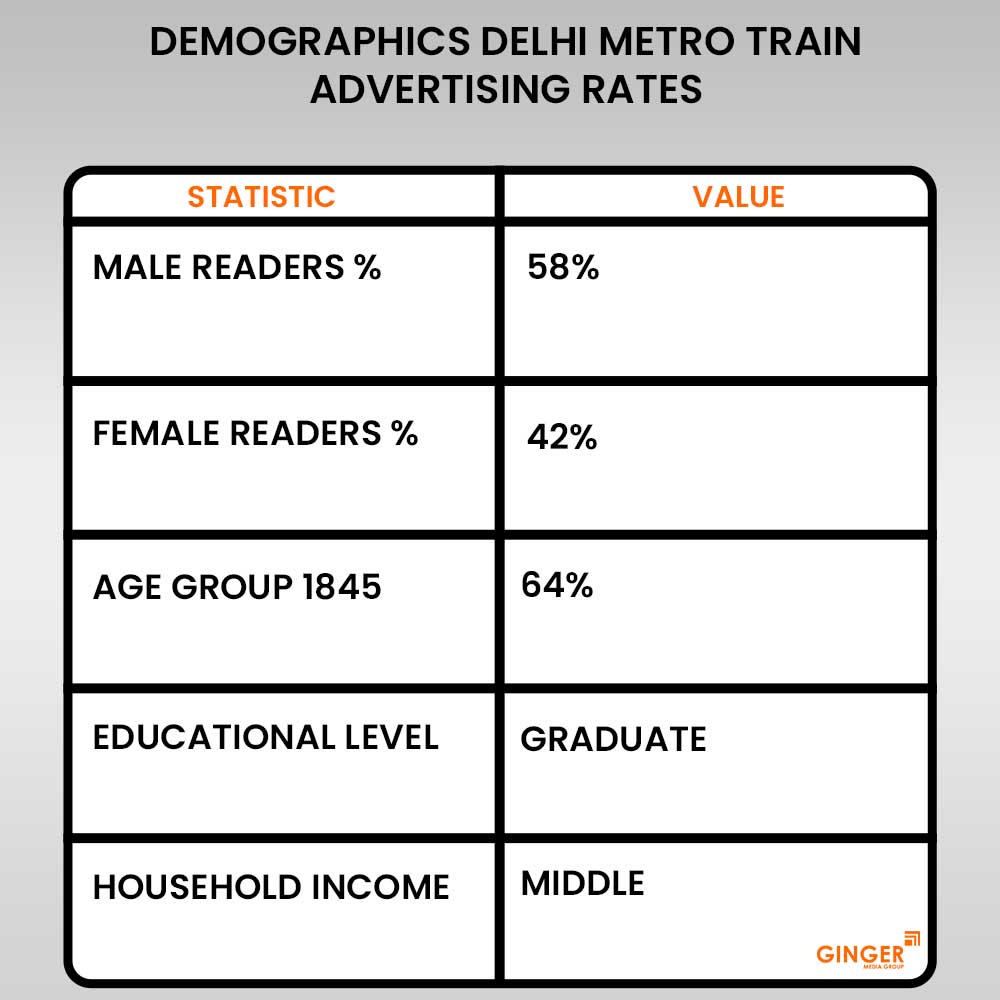
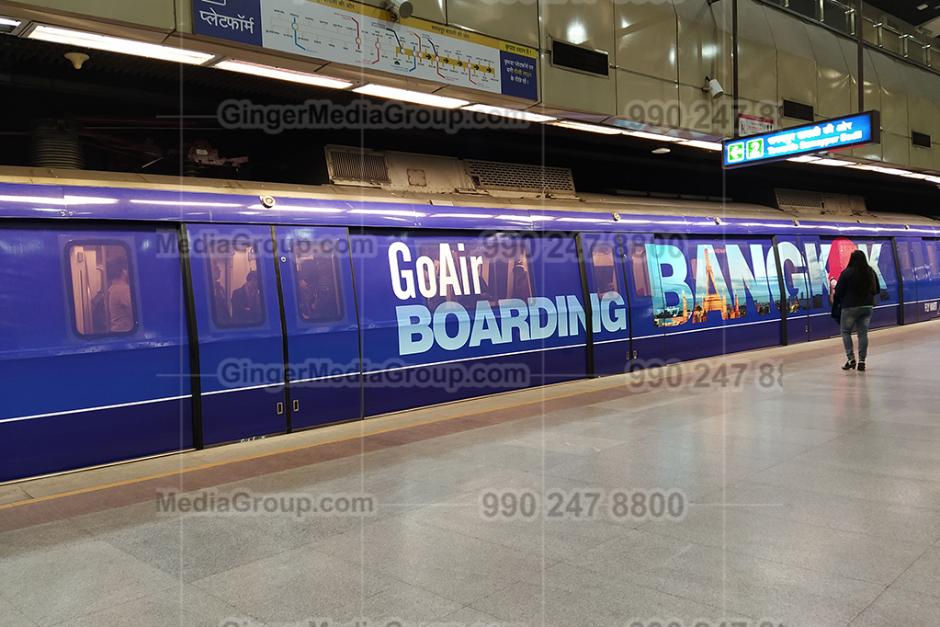
Ad Format of Advertising on the Delhi Metro Train
The Delhi Metro offers various advertising formats that cater to different branding needs and objectives. These formats are strategically designed to capture the attention of commuters, providing high visibility and engagement opportunities throughout their journey.
From large wall panels to innovative grab handles, each format offers unique advantages for advertisers aiming to create impactful and memorable campaigns.
Wall Panels
Wall panels in the Delhi Metro are large advertising spaces placed on the sides of the coach interiors. These panels offer high visibility, making them ideal for bold branding and messaging. Positioned at eye level, they capture the attention of seated and standing passengers alike, ensuring that the advertisement is seen by a significant portion of the commuters. The size of the wall panels allows for creative and visually striking advertisements that can include detailed images, vibrant colors, and compelling text, making them perfect for product launches, event promotions, and brand awareness campaigns.
The effectiveness of wall panels is further enhanced by the extended exposure time. Passengers spend an average of 20-30 minutes per journey, during which they are likely to notice and absorb the advertisements multiple times. This repeated exposure helps reinforce the brand message, leading to higher recall rates and stronger brand associations. Additionally, the strategic placement of these panels ensures that they are visible even during peak travel times when the metro is crowded, thus maximizing the reach and impact of the advertisements.
Shelf Branding
Shelf branding involves placing advertisements on the overhead shelves where passengers store their luggage. This unique advertising format offers good visibility, as the shelves are within the natural line of sight of standing and seated passengers. The unobtrusive placement ensures that the ads do not interfere with the passengers' comfort while still being prominently displayed, making it an effective medium for consistent brand messaging.
The overhead location of the shelves provides a captive audience, as passengers often glance at the shelves to check their belongings or simply out of habit during their journey. This repeated exposure to the ads can lead to increased brand recall and familiarity. Additionally, shelf branding is particularly effective for promoting travel-related products and services, as passengers storing their luggage may be more receptive to advertisements related to travel insurance, hotels, or local attractions. The strategic placement of ads on shelves ensures high visibility and engagement, making it a valuable advertising format in the Delhi Metro.
Grab Handles
Branding on grab handles is an innovative advertising format that leverages a unique touchpoint for brand interaction. Grab handles are used by passengers for support during their journey, making them a frequently touched and noticed element within the train. By placing advertisements on these handles, brands can achieve high visibility and repeated exposure, as passengers are likely to notice the branding every time they use the handles.
This format offers a distinct advantage in terms of engagement, as it directly interacts with the passengers' daily commute. The physical interaction with the grab handles helps create a tactile association with the brand, reinforcing brand recall and familiarity. Additionally, the novelty of this advertising format can capture the attention of passengers, making the ads more memorable. Grab handle branding is especially suitable for brands looking to create a strong, memorable presence in the daily lives of Delhi Metro commuters, ensuring that their message is seen and remembered.
Door Panels
Door panels are strategically placed advertisements on the inside of train doors, visible to passengers as they enter and exit the coach. This high-traffic area guarantees that the advertisements are seen multiple times during a single journey, maximizing exposure and impact. The prominent placement ensures that the ads are unavoidable, capturing the attention of passengers at crucial moments of their commute.
The effectiveness of door panel advertisements lies in their ability to deliver concise,
impactful messages within a limited space. Given the frequent opening and closing of train doors, these ads must be designed to convey their message quickly and effectively. The high visibility and repeated exposure provided by door panels make them an excellent choice for time-sensitive promotions, important announcements, or brand reinforcement campaigns. The strategic location of these ads ensures they are noticed by all passengers, enhancing brand recall and engagement.
Vestibule Panels
Vestibule panels are located at the ends of each coach, providing additional space for targeted messaging. These panels are particularly effective because they are positioned in areas where passengers often stand or move between coaches, ensuring high visibility and engagement. The placement of vestibule panels allows for uninterrupted viewing, making them ideal for detailed advertisements that require more attention from the audience.
The advantage of vestibule panels lies in their ability to capture the attention of passengers in a relatively less crowded part of the train. This format is perfect for brands looking to communicate detailed information or complex messages, as passengers are more likely to spend time reading and absorbing the content. The strategic positioning of vestibule panels ensures that they are noticed by commuters, leading to increased brand recall and engagement. This format offers a valuable opportunity for advertisers to reach a captive audience in a high-visibility area of the train.
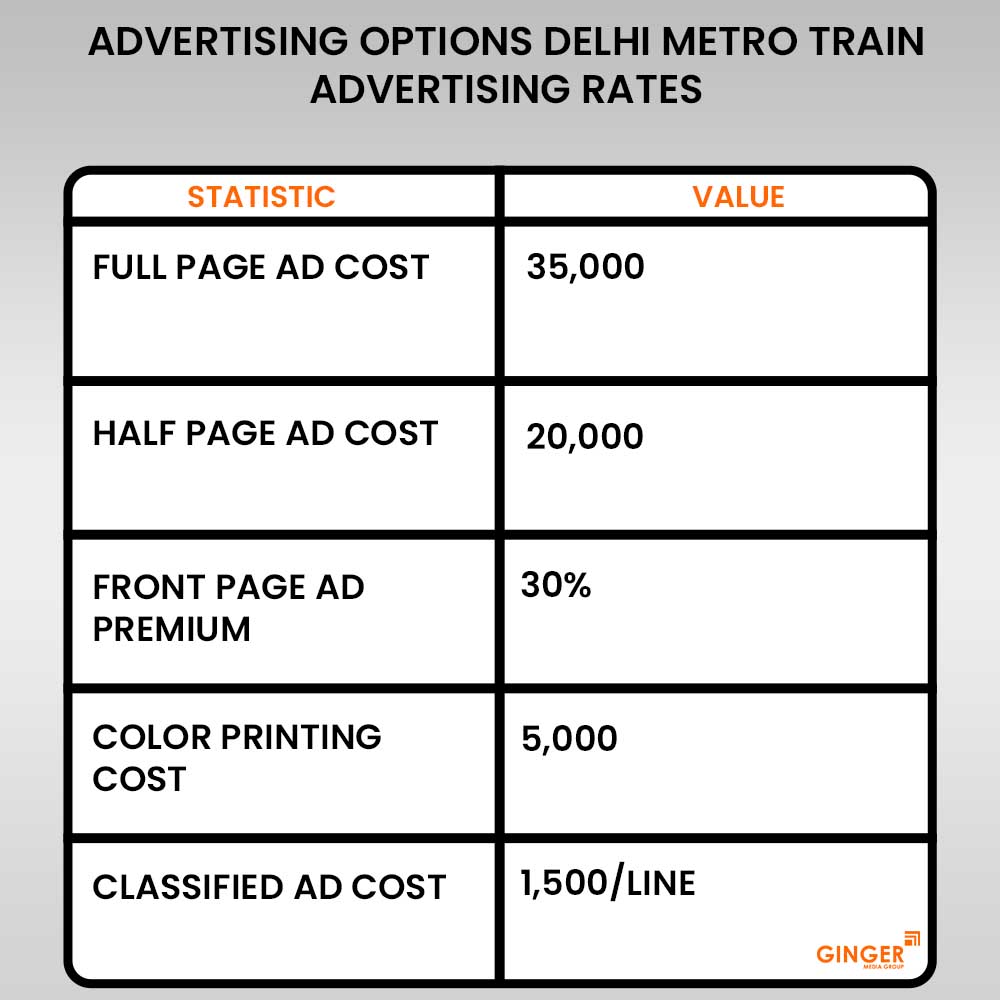
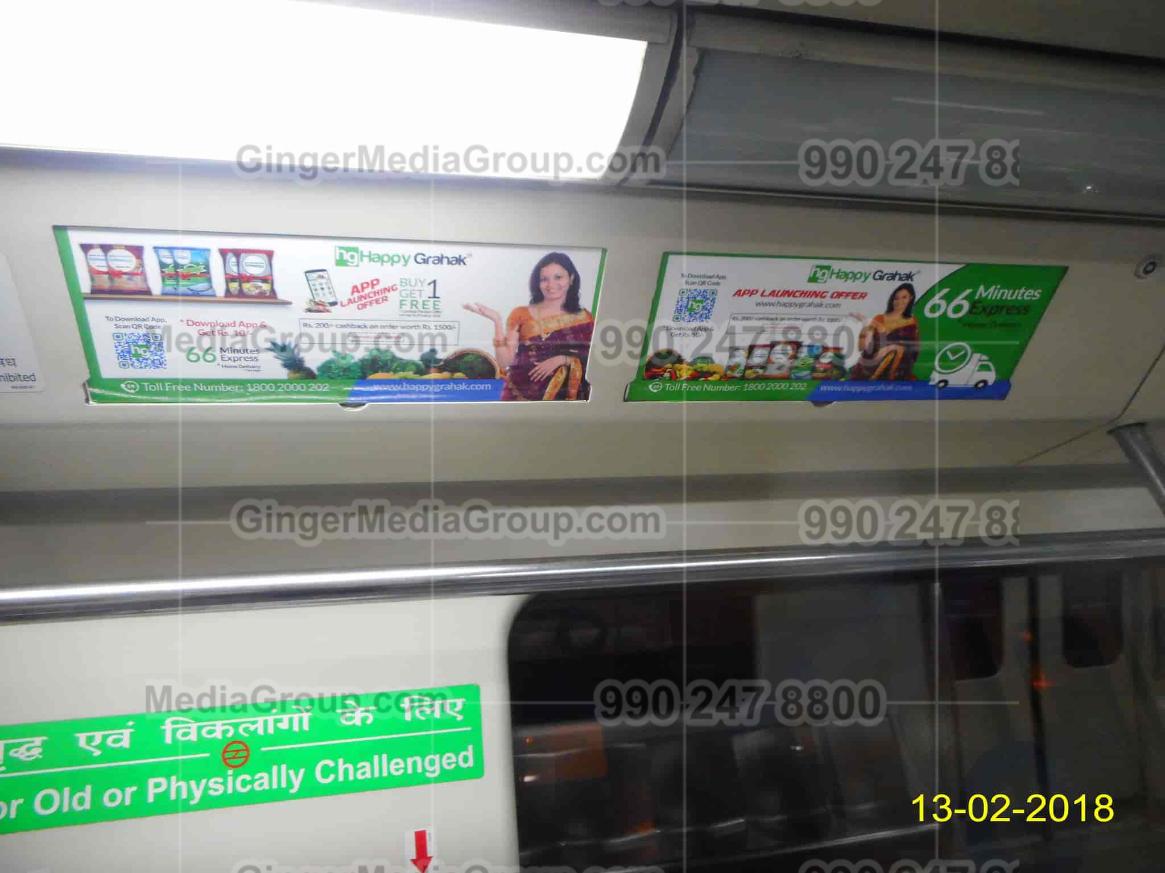
Want to do Advertising on the Delhi Metro Train for brand promotions?
Factors Affecting the Cost of Advertising on the Delhi Metro Train
The cost of advertising in the Delhi Metro is influenced by various factors, each contributing to the overall expense and effectiveness of the campaign. Understanding these factors is crucial for businesses to optimize their advertising budget and achieve the desired reach and impact.
From the timing of the campaign to the type of ad format chosen, each element plays a significant role in determining the final cost. By considering these factors, advertisers can make informed decisions that align with their marketing objectives and budget constraints.
Campaign Seasonality
One of the primary factors affecting the cost of advertising in the Delhi Metro is campaign seasonality. Advertising during peak seasons, such as Diwali, Christmas, or other festive holidays, tends to be more expensive due to increased demand for ad space. During these periods, businesses across various sectors ramp up their marketing efforts to capitalize on heightened consumer spending and festive cheer. This surge in demand leads to increased competition for prime advertising spots, driving up prices.
However, advertising during peak seasons also offers significant benefits. The heightened consumer activity and festive atmosphere can enhance the effectiveness of advertisements, leading to higher engagement and conversion rates. For businesses, the potential return on investment during these periods can justify the higher costs. To manage expenses, advertisers can plan their campaigns well in advance and secure ad spaces early, taking advantage of any early-bird discounts or pre-season offers. By strategically timing their campaigns and understanding the seasonal dynamics, businesses can maximize their advertising impact while managing costs effectively.
Creative Complexity
The complexity of the creative design significantly impacts the cost of advertising in the Delhi Metro. Simple ad designs are generally cheaper to produce and install compared to those with intricate elements or special effects. For instance, a basic ad with minimal text and graphics will incur lower production costs than a complex design featuring interactive elements, 3D visuals, or special lighting effects. The additional resources required for designing, printing, and installing complex ads contribute to the higher costs.
Despite the higher expenses, creatively complex ads can offer substantial advantages in terms of engagement and memorability. Unique and visually appealing advertisements are more likely to capture the attention of commuters, leading to increased brand recall and interaction. Businesses must weigh the benefits of creative complexity against the associated costs, ensuring that the investment aligns with their marketing goals and budget. By balancing creativity with cost-efficiency, advertisers can create impactful campaigns that resonate with their target audience without exceeding their financial constraints.
Ad Format
The choice of ad format is another critical factor influencing the cost of advertising in the Delhi Metro. Different ad formats offer varying levels of visibility and engagement, with high-visibility formats commanding a premium price. For example, a full train wrap, which covers an entire train with branded graphics, offers maximum exposure and impact but is significantly more expensive than smaller ad formats like shelf branding or grab handle ads. The extensive coverage and high visibility of full train wraps justify the higher costs, making them ideal for large-scale brand awareness campaigns.
On the other hand, smaller ad formats, while more cost-effective, offer more targeted and localized exposure. Advertisers must choose the ad format based on their specific objectives and budget. For brands seeking widespread recognition and a strong visual presence, investing in high-visibility formats may provide the desired results. Conversely, businesses with limited budgets can opt for smaller formats that still offer strategic placement and effective engagement. Understanding the cost implications of different ad formats helps advertisers make informed decisions that align with their marketing strategies and financial resources.
Campaign Duration
The duration of the advertising campaign is a significant factor in determining the overall cost. Longer campaigns naturally incur higher costs due to the extended use of ad spaces and the need for ongoing maintenance and monitoring. However, many media vendors offer discounts or cost savings for longer-term commitments, recognizing the value of sustained advertising exposure. By committing to longer durations, advertisers can often negotiate better rates, reducing the cost per impression and enhancing the overall cost-efficiency of the campaign.
Extended campaigns also offer the advantage of repeated exposure, which is crucial for building brand recall and familiarity among commuters. The consistent presence of ads over a prolonged period ensures that the brand remains top-of-mind for the target audience, leading to stronger engagement and higher conversion rates. Advertisers must balance the benefits of prolonged exposure with the associated costs, planning their campaign durations strategically to achieve maximum impact while managing their advertising budgets effectively. By leveraging vendor discounts and optimizing campaign durations, businesses can enhance the effectiveness and cost-efficiency of their metro advertising efforts.
Train Coach Type
Advertising costs in the Delhi Metro can also vary based on the type of train coach selected. There might be a slight price difference between advertising in regular coaches and those in special compartments such as AC coaches or women's coaches. Special compartments often attract specific demographics, offering targeted advertising opportunities. For instance, AC coaches typically cater to a more affluent segment of commuters, providing a valuable platform for premium brands seeking to reach high-income consumers.
Similarly, women's coaches, designated for female passengers, offer a targeted audience for brands focusing on women's products and services. The specialized nature of these compartments can justify the higher advertising costs, as they provide a focused and relevant audience for specific campaigns. Advertisers must consider the demographics and preferences of commuters in different coach types, aligning their ad placements with their target audience to optimize engagement and impact. By strategically selecting the appropriate coach types and understanding the associated cost variations, businesses can effectively tailor their advertising efforts to reach the most relevant and receptive audiences within the Delhi Metro system.
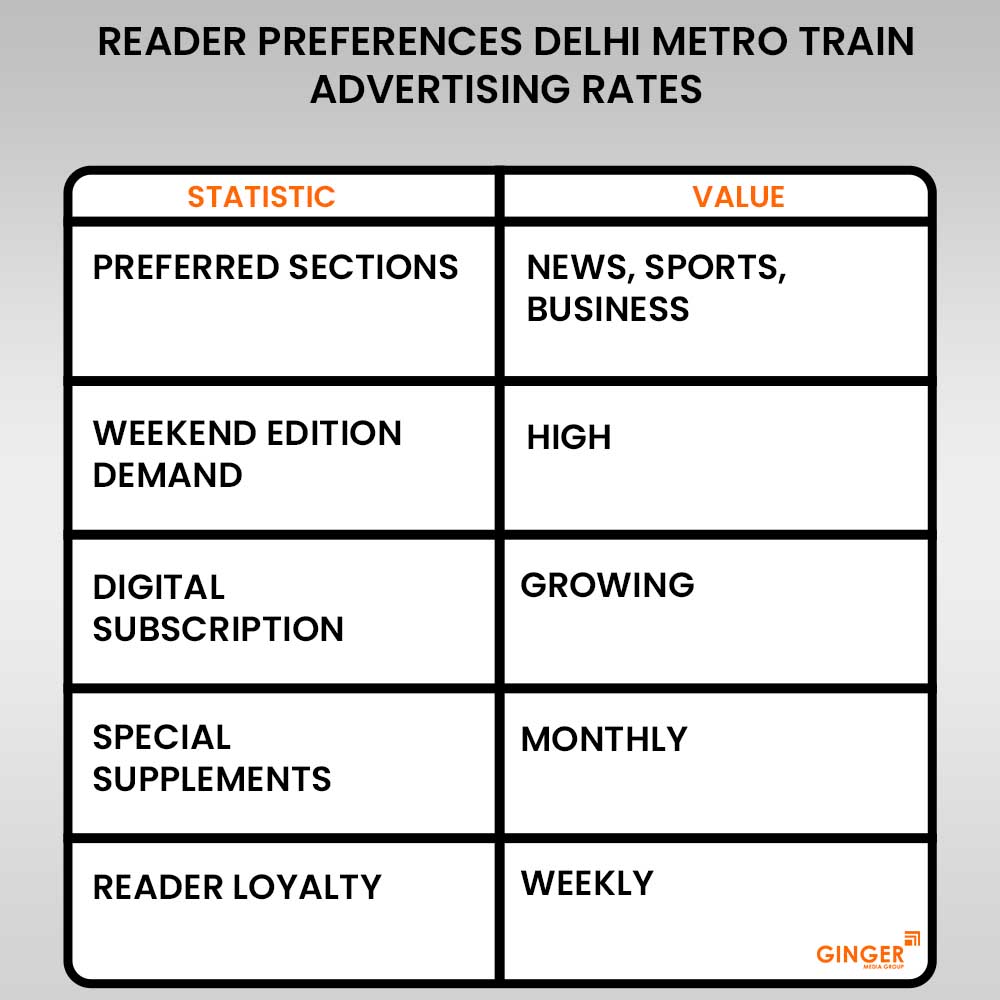
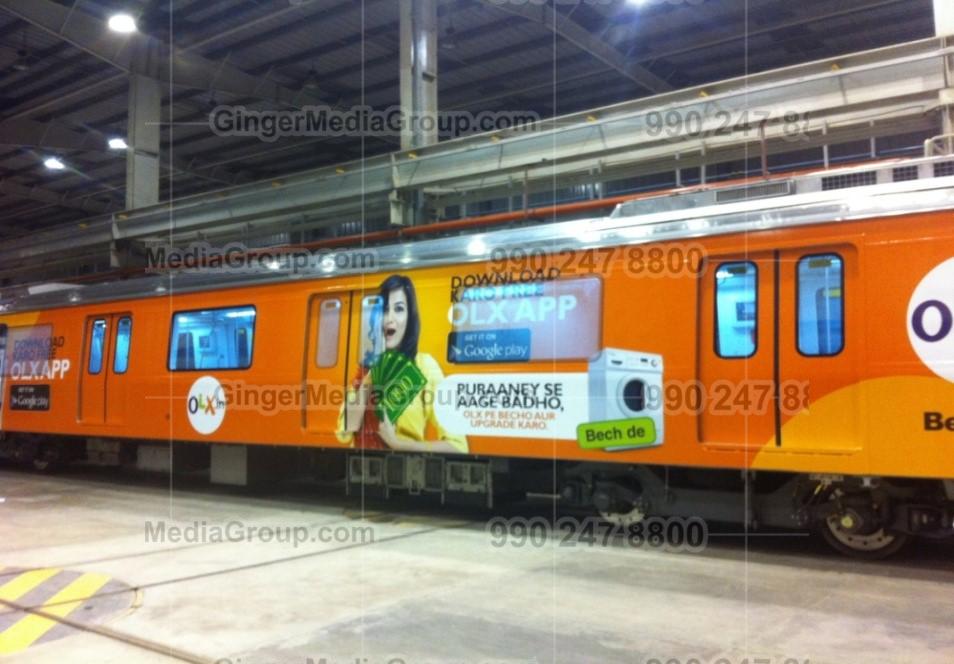
Best Practices for Advertising on the Delhi Metro Train
Advertising in the Delhi Metro presents unique opportunities and challenges for brands aiming to capture the attention of millions of commuters daily. To maximize the effectiveness of metro advertising, it is essential to follow best practices that ensure messages are clear, engaging, and strategically placed.
By keeping messages concise, using visually appealing designs, incorporating compelling calls to action, choosing the right formats, and selecting strategic stations, advertisers can create impactful campaigns that resonate with their target audience and achieve their marketing objectives.
Keep it Clear and Concise
One of the most crucial best practices for metro advertising is to keep the message clear and concise. Commuters have limited time to view advertisements as they move quickly through stations or glance around during their journeys. Therefore, it is essential to craft messages that are easy to understand at a glance. The key to achieving this is simplicity. Avoid cluttered designs and excessive text. Instead, focus on a single, powerful message that communicates the core of your brand or campaign effectively.
Use short, punchy headlines and minimal text to convey your message. The visual hierarchy should guide the viewer's eye to the most important information first, ensuring that the message is quickly and easily absorbed. Additionally, use bold and legible fonts that can be read from a distance, and ensure that the text contrasts well with the background for maximum visibility. By keeping the message clear and concise, advertisers can ensure that their campaigns are noticed and remembered by commuters, even with the brief exposure time available.
Visually Appealing
Creating visually appealing advertisements is essential for capturing the attention of commuters in the Delhi Metro. High-quality visuals that align with your brand image and the metro environment can significantly enhance the impact of your campaign. Use vibrant colors, sharp images, and professional design elements to make your ads stand out. The visual appeal of your ad can draw in viewers, making them more likely to engage with the content and remember your brand.
Incorporate imagery and design elements that resonate with your target audience. For example, if your brand targets young professionals, use modern and sleek designs that appeal to their aesthetic preferences. Additionally, consider the surroundings of the metro environment when designing your ads. Ensure that your visuals are appropriate for the setting and that they complement the overall look and feel of the metro stations and trains. By prioritizing visual appeal, advertisers can create memorable and impactful campaigns that leave a lasting impression on commuters.
Compelling Call to Action
A compelling call to action (CTA) is a critical component of effective metro advertising. Your CTA should clearly tell viewers what you want them to do next, whether it’s visiting your website, downloading an app, or simply remembering your brand. A strong CTA guides the viewer toward the desired action, increasing the likelihood of engagement and conversion. Use clear and direct language in your CTA, such as “Visit our website,” “Download now,” or “Join us today.”
Position the CTA prominently in your ad design to ensure it stands out and catches the viewer’s attention. Use contrasting colors or bold fonts to make the CTA visually distinct from other elements in the ad. Additionally, consider offering incentives or highlighting benefits to encourage action. For example, phrases like “Get 20% off your first purchase” or “Exclusive offer for metro commuters” can create a sense of urgency and motivate viewers to act. By incorporating a compelling and clear CTA, advertisers can drive engagement and achieve their campaign goals more effectively.
Choose the Right Format
Selecting the right ad format is crucial for maximizing the impact of your metro advertising campaign. The Delhi Metro offers various formats, such as interior panels, digital screens, wall panels, and grab handles, each with its unique advantages. When choosing a format, consider factors such as visibility, dwell time, and your target audience. Interior panels and digital screens, for example, offer high visibility and are ideal for engaging commuters during their journeys.
Match the format to your creative and budget. High-impact formats like full train wraps or large digital screens may be more expensive but offer extensive reach and engagement. On the other hand, smaller formats like grab handles or shelf branding can be more cost-effective while still providing strategic placement. Consider the dwell time of commuters as well; formats that are in direct line of sight or near areas where passengers spend more time, such as waiting areas or door panels, can enhance engagement. By choosing the right format, advertisers can optimize their budget and achieve the desired reach and impact for their campaigns.
Strategic Station Selection
Strategic station selection is essential for targeting the right audience and maximizing the effectiveness of metro advertising. Different stations attract varying demographics, so it’s important to choose locations based on your target audience. For example, if your brand targets professionals and business commuters, advertising in stations near commercial hubs like Connaught Place or Nehru Place would be beneficial. Similarly, if your audience includes students, stations near educational institutions like the University of Delhi or IIT Delhi would be ideal.
Additionally, consider stations with high foot traffic for broader reach. Stations like Rajiv Chowk, Kashmere Gate, and Central Secretariat see a large volume of commuters daily, offering extensive exposure. Analyze commuter patterns and demographics to identify key stations that align with your target market. Tailor your advertising strategy to these locations to ensure your message reaches the most relevant and receptive audience. By strategically selecting stations, advertisers can enhance the visibility and impact of their campaigns, driving engagement and achieving their marketing goals more effectively.
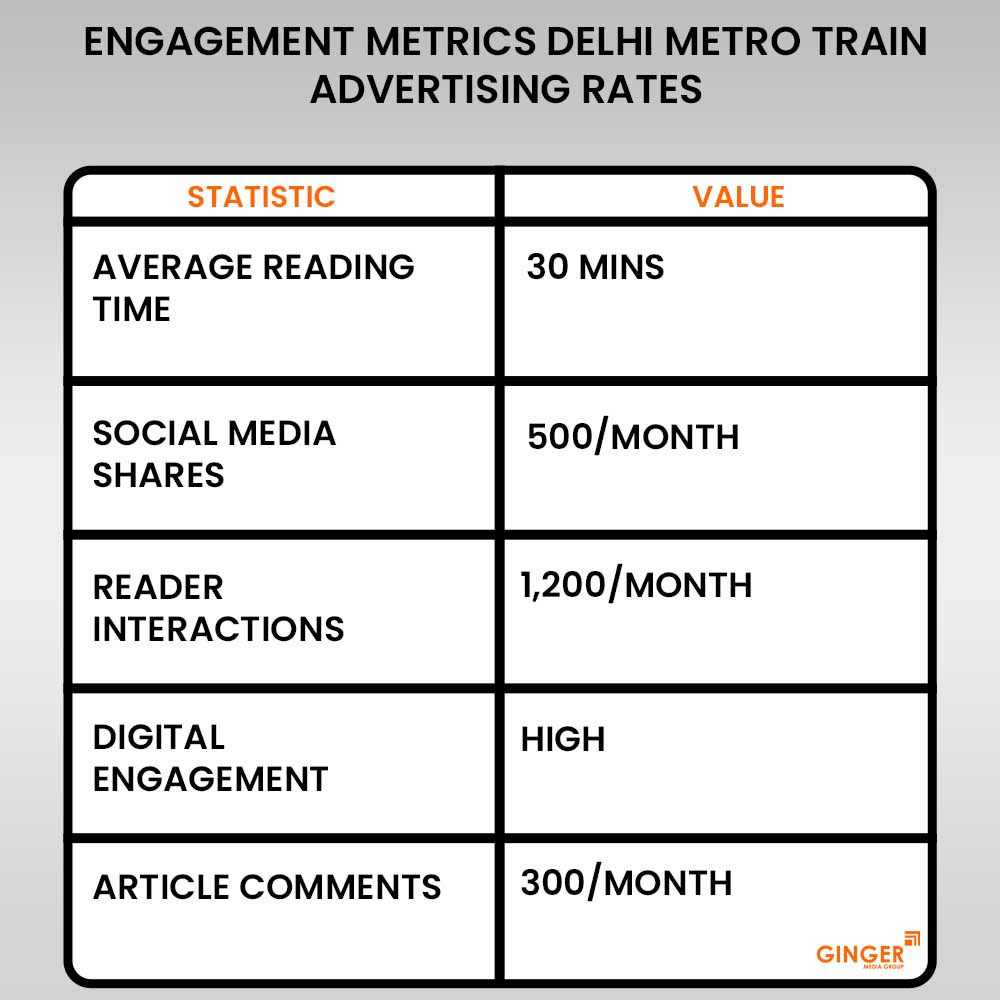
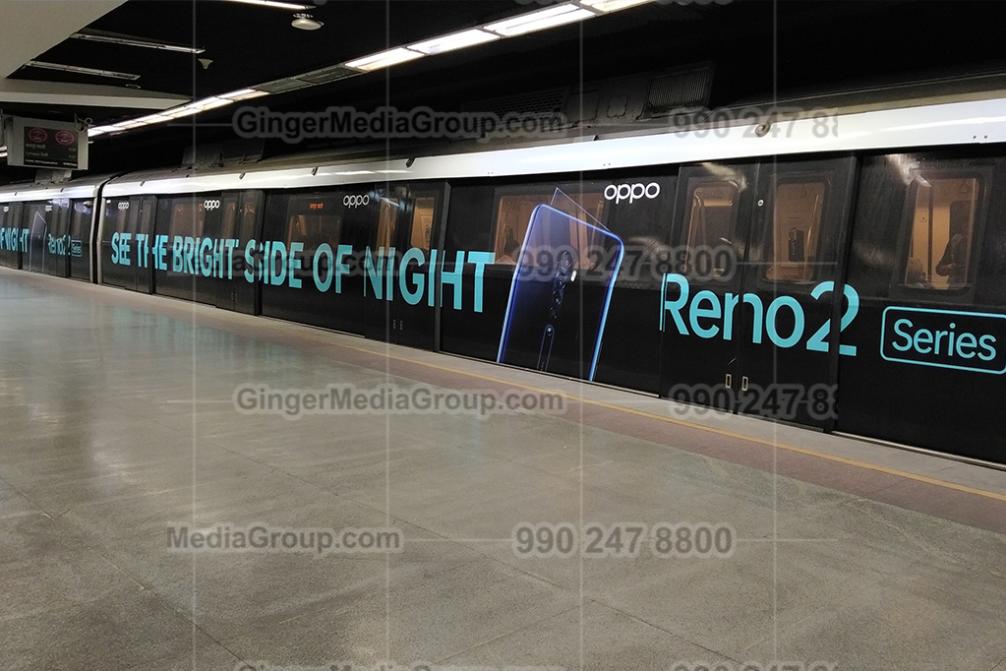
Guide for Creating Effective Advertising on the Delhi Metro Train
Creating effective advertising on the Delhi Metro requires a strategic approach that leverages the unique environment and audience engagement opportunities presented by this urban transit system. The Delhi Metro's extensive network, high passenger volume, and diverse commuter demographics provide a fertile ground for impactful advertising campaigns. To maximize the effectiveness of your Metro advertising efforts, it is essential to consider several key factors, from understanding your target audience to choosing the right ad formats and crafting compelling messages. Here are seven crucial points to help you create effective advertising on the Delhi Metro:
Understand Your Target Audience
Understanding your target audience is the cornerstone of any successful advertising campaign. In the context of Delhi Metro advertising, this involves analyzing the demographic and psychographic profiles of the Metro's commuters. The Delhi Metro serves a wide array of passengers, including business professionals, students, tourists, and residents from various socioeconomic backgrounds. To tailor your advertising effectively, you need to segment this diverse audience and identify the specific groups that align with your brand’s objectives. Start by conducting thorough market research to gather insights into the preferences, behaviors, and needs of different commuter segments. This information will guide your creative decisions and help you develop messages that resonate with each target group.
Moreover, understanding your target audience involves recognizing the unique characteristics and travel patterns of Metro users. For instance, business professionals commuting during peak hours might be more receptive to advertisements related to finance, technology, or career development. In contrast, students and younger audiences might respond better to ads featuring entertainment, fashion, or educational opportunities. By mapping out these nuances, you can create customized advertising content that speaks directly to the interests and motivations of each segment. This targeted approach enhances the relevance and impact of your ads, leading to higher engagement and conversion rates.
Choose the Right Ad Formats
The Delhi Metro offers a variety of advertising formats, each with its unique advantages and potential for audience engagement. Selecting the appropriate format is crucial for maximizing the effectiveness of your campaign. Interior train branding panels, floor graphics, ceiling panels, pillar wraps, and seat backs/headrests are some of the prominent formats available. Each format serves a different purpose and can be used to achieve specific advertising goals. For example, interior train branding panels are ideal for delivering high-impact visual messages that passengers can see throughout their journey, while floor graphics create an immersive experience by utilizing often-overlooked spaces.
To choose the right ad format, consider the nature of your message and the desired interaction with your audience. If your campaign aims to create a strong visual impact, ceiling panels and pillar wraps might be more effective due to their prominent placement and visibility. On the other hand, if you want to engage passengers with interactive content or create a unique brand experience, floor graphics or digital screens could be the ideal choice. By aligning your ad format with your campaign objectives and understanding how passengers interact with different parts of the train environment, you can enhance the overall impact of your advertising efforts.
Craft Compelling and Clear Messages
Creating compelling and clear messages is vital for effective advertising on the Delhi Metro. Given the short attention span of commuters and the bustling environment of the Metro, your ad needs to grab attention quickly and convey its message succinctly. Start with a strong headline that immediately captures interest and communicates the core message of your campaign. Use concise and straightforward language to ensure that your message is easily understood at a glance. Visual elements such as images, graphics, and colors should complement the text and reinforce the overall message.
In addition to clarity, the emotional appeal of your message plays a significant role in its effectiveness. Consider the emotions you want to evoke in your audience—whether it's excitement, curiosity, trust, or urgency. Tailor your content to resonate with these emotions, making it more memorable and impactful. For instance, a campaign promoting a new product launch might use vibrant visuals and enthusiastic language to generate excitement, while a public service announcement could employ a more sober tone and compelling imagery to elicit empathy and concern. By crafting messages that are both clear and emotionally engaging, you can capture the attention of Metro commuters and leave a lasting impression.
Utilize High-Quality Visuals and Design
High-quality visuals and design are essential components of successful Metro advertising campaigns. Given the visual nature of advertising spaces within the Metro, the quality of your images, graphics, and overall design can significantly impact the effectiveness of your ads. Use high-resolution images and professional graphics to ensure that your advertisements look sharp and appealing from any viewing distance. Consistent branding elements such as logos, colors, and fonts should be integrated seamlessly into the design to reinforce brand recognition and cohesion.
Effective design also involves strategic placement and composition of visual elements. Ensure that key messages and call-to-action elements are prominently positioned within the ad space, making them easy to read and engage with. Use contrasting colors to enhance readability and draw attention to important information. Additionally, consider the flow of the design—guide the viewer's eye through the ad in a way that naturally leads to the desired action or takeaway. By investing in high-quality visuals and thoughtful design, you can create advertisements that not only attract attention but also effectively communicate your brand's message and value proposition.
Leverage Repetition and Consistency
Repetition and consistency are powerful tools in advertising, particularly in a high-frequency environment like the Delhi Metro. Repeated exposure to your advertisements helps reinforce your message and increase brand recall among commuters. Utilize multiple ad placements within the Metro system to ensure that passengers encounter your ads several times during their journey. This can be achieved by placing similar ads in various carriages, stations, and key points within the Metro network.
Consistency in messaging and design across all ad placements further strengthens brand recognition. Ensure that your advertisements maintain a cohesive look and feel, with consistent use of branding elements, colors, and messaging. This uniformity not only enhances the professional appearance of your campaign but also makes it easier for passengers to associate different ads with your brand. By leveraging repetition and consistency, you can create a pervasive presence within the Metro system, making your brand more familiar and memorable to commuters.
Incorporate Interactive and Engaging Elements
Incorporating interactive and engaging elements into your Metro advertisements can significantly enhance their effectiveness. Interactive ads invite passengers to participate actively, creating a more memorable and enjoyable experience. Consider using QR codes that lead to exclusive content, discounts, or contests. Digital screens within the Metro offer opportunities for dynamic and interactive content, such as videos, animations, or interactive games that can capture and hold the attention of commuters.
Engaging elements also include call-to-action prompts that encourage immediate responses from passengers. Phrases like "Scan for More Info," "Join Our Contest," or "Visit Our Website" can drive engagement and interaction. Additionally, leveraging social media integration by prompting commuters to share their experiences or thoughts about your ad campaign can extend its reach beyond the Metro environment. By incorporating interactive and engaging elements, you can create a more dynamic advertising experience that resonates with passengers and drives higher levels of engagement and response.
Monitor and Evaluate Campaign Performance
Monitoring and evaluating the performance of your Metro advertising campaign is crucial for understanding its effectiveness and making necessary adjustments. Establish clear metrics and KPIs to measure the success of your campaign, such as brand awareness, engagement rates, and conversion rates. Utilize tools and analytics to track these metrics and gather data on how commuters are interacting with your ads. This data can provide valuable insights into which elements of your campaign are working well and which areas may need improvement.
Regularly reviewing and analyzing campaign performance allows you to make data-driven decisions and optimize your advertising strategy. If certain ad placements or formats are underperforming, consider testing alternative approaches or adjusting your messaging and visuals. Continuous monitoring also helps you stay agile and responsive to changing trends and commuter behaviors. By maintaining a proactive approach to campaign evaluation, you can ensure that your Metro advertising efforts remain effective, relevant, and aligned with your overall marketing goals.
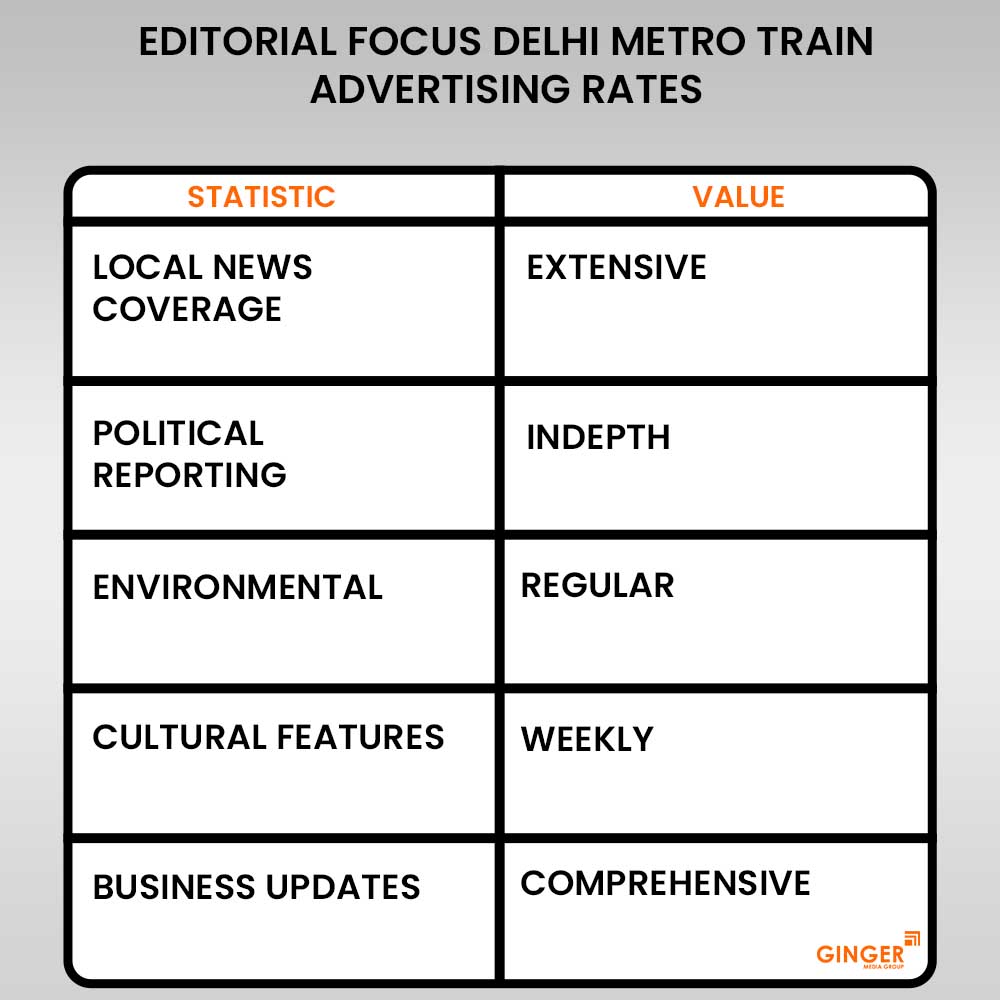
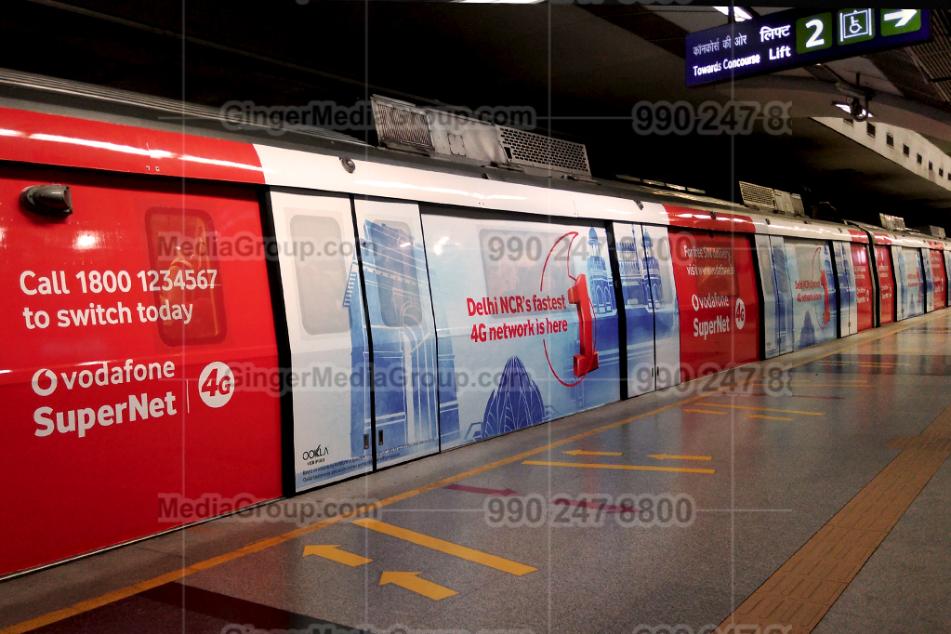
Want to do Advertising on the Delhi Metro Train for brand promotions?
Why Choose Ginger Media Group for Advertising on the Delhi Metro Train?
Choosing the right partner for your advertising campaign on the Delhi Metro is crucial for maximizing your return on investment and achieving your marketing objectives. Ginger Media Group stands out as a premier choice for several compelling reasons.
With a proven track record of success, comprehensive expertise in metro advertising, and a commitment to delivering exceptional service, Ginger Media Group is equipped to help you create impactful and effective advertising campaigns on the Delhi Metro. Here are key reasons why you should choose Ginger Media Group for your Delhi Metro train advertising needs:
Proven Track Record of Success: Ginger Media Group has an impressive portfolio of successful advertising campaigns across various industries. Our experience in metro advertising, combined with our deep understanding of the unique dynamics of the Delhi Metro environment, allows us to design and execute campaigns that deliver results. Our proven track record speaks to our ability to create advertisements that resonate with diverse commuter audiences, driving brand awareness, engagement, and conversions. By partnering with us, you benefit from our extensive experience and expertise, ensuring that your campaign is in capable hands.
Our past campaigns have consistently demonstrated significant increases in brand visibility and consumer engagement. We have worked with numerous high-profile clients, helping them achieve their marketing goals through strategically designed Metro advertising campaigns. Our success stories include boosting product launches, increasing footfall to retail locations, and enhancing brand perception. By leveraging our proven methodologies and best practices, you can be confident that your advertising campaign will be executed with precision and effectiveness.
Comprehensive Expertise in Metro Advertising: Metro advertising requires a nuanced understanding of commuter behavior, spatial dynamics, and creative execution. Ginger Media Group excels in these areas, offering comprehensive expertise that spans every aspect of Metro advertising. Our team of professionals is skilled in designing advertisements that capture attention in the fast-paced Metro environment, crafting compelling messages that resonate with commuters, and selecting the most effective ad formats to achieve your objectives. We stay up-to-date with the latest trends and innovations in Metro advertising, ensuring that your campaign benefits from cutting-edge strategies and techniques.
We understand that each campaign is unique and requires a tailored approach. Our experts work closely with you to understand your brand, target audience, and marketing goals. We conduct thorough research and analysis to develop a strategic advertising plan that maximizes the impact of your message. From concept development and creative design to media planning and execution, we handle every step of the process with meticulous attention to detail. Our comprehensive expertise ensures that your campaign is not only visually appealing but also strategically aligned with your objectives.
Strategic Ad Placement: One of the critical factors in the success of Metro advertising is the strategic placement of ads to maximize visibility and impact. Ginger Media Group excels in identifying and securing prime ad locations within the Delhi Metro network. We understand the flow of commuter traffic and the hotspots for maximum exposure. Our strategic ad placement ensures that your advertisements are seen by a large and diverse audience, enhancing brand recognition and recall. Whether it's interior train branding panels, floor graphics, ceiling panels, or pillar wraps, we know how to position your ads for optimal effectiveness.
Our team conducts a thorough analysis of commuter patterns and station footfall to identify the best locations for your advertisements. We leverage our extensive network and relationships with Metro authorities to secure premium ad placements that align with your target audience's travel routes. By strategically placing your ads in high-traffic areas, we ensure that your message reaches the right people at the right time. Our focus on strategic ad placement maximizes the impact of your campaign, driving higher engagement and conversions.
Customized Solutions and Creative Excellence: At Ginger Media Group, we believe that every brand has a unique story to tell. That's why we offer customized advertising solutions tailored to your specific needs and goals. Our creative team works closely with you to develop advertisements that reflect your brand identity and resonate with your target audience. We pride ourselves on our creative excellence, producing visually stunning and engaging advertisements that stand out in the crowded Metro environment. Our customized solutions ensure that your campaign is not only effective but also uniquely yours.
We take a collaborative approach to the creative process, involving you at every stage to ensure that the final product aligns with your vision and objectives. Our team of designers, copywriters, and marketing strategists brings a wealth of experience and creativity to the table. We explore innovative design concepts, compelling messaging, and impactful visuals to create ads that capture attention and drive action. By choosing Ginger Media Group, you gain access to our creative excellence and customized solutions that elevate your brand's presence in the Delhi Metro.
Comprehensive Campaign Management: Managing a successful advertising campaign involves more than just creating compelling ads. It requires meticulous planning, execution, and monitoring to ensure that your campaign achieves its goals. Ginger Media Group offers comprehensive campaign management services, handling every aspect of your Metro advertising campaign from start to finish. Our dedicated team oversees the entire process, from initial planning and creative development to media buying, installation, and performance tracking. We provide regular updates and detailed reports, allowing you to monitor the progress and success of your campaign.
Our comprehensive campaign management ensures that your advertising efforts are seamless and stress-free. We take care of all the logistics, including obtaining necessary permits, coordinating with Metro authorities, and ensuring timely installation and maintenance of your ads. Our team is always available to address any concerns or make adjustments to optimize your campaign's performance. By partnering with us, you can focus on your core business while we handle the intricacies of your Metro advertising campaign with expertise and efficiency

Ginger Media Group is a 360 degrees marketing agency that specialises in outdoor advertising. With our 7+ years of experience, our team of branding specialists, marketing enthusiasts and data-driven advertisers, we have had the pleasure to serve some of the most well-known brands such as VIBGYOR, OYO, Zomato, Uber Moto, Uber Eats, Chumbak & a lot more.
